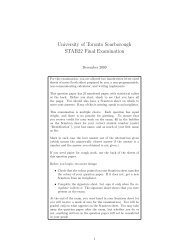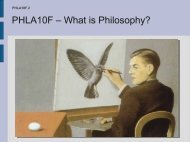Reading List - University of Toronto Scarborough
Reading List - University of Toronto Scarborough
Reading List - University of Toronto Scarborough
- No tags were found...
You also want an ePaper? Increase the reach of your titles
YUMPU automatically turns print PDFs into web optimized ePapers that Google loves.
ECMD13: Advanced Microeconomic Theory<strong>Reading</strong> <strong>List</strong>Jim Campbelljcampbell@utsc.utoronto.caThe following is a suggested reading list for ECMD13. Each topic in this course could rightlyform a full course on its own right, and so this reading list is both extensive and vastlyincomplete. You do not have to read everything on this list! My favorites are marked with anasterisk.This list is designed to go beyond each week’s required reading (assigned in lecture). To bestprepare you for writing essays in your exams I encourage you to read more when you areinterested, even if it’s just to skim an article to get an idea <strong>of</strong> it. I encourage you also to feel freeto read outside this list and to draw on a breadth <strong>of</strong> sources in your research. The referenceswithin these references are one good place to dig deeper.Note that many <strong>of</strong> these references are primary sources in the economics literature and so canbe quite technical. A good way to approach your reading is to use my lecture notes and thetextbooks to understand the basics, and to tackle the literature with the goal <strong>of</strong> understandingthe logic, argument and approach <strong>of</strong> the authors rather than the mathematical and technicaldetails.Google Scholar should help you to find many <strong>of</strong> the journal articles listed below. If you havedifficulty finding anything, let me know and I will help.General textbooks Freely available:Rubinstein, A., Lecture Notes in Microeconomic Theory,http://arielrubinstein.tau.ac.il/Rubinstein2007.pdf, updated 2010 [Topic 1]Tian, G., Lecture Notes in Microeconomic Theory, http://econweb.tamu.edu/tian/micro1.pdf,updated 2010 [Comprehensive but pitched at a high-level]Osborne, M. and Rubinstein, A., A Course in Game Theory,http://theory.economics.utoronto.ca/books/index.php/index, 1994 [Register todownload; refer to this for our game theory section] To buy or reference if you wantMas-Colell, A., Whinston, M.D. and Green, J.R., Microeconomic Theory, Oxford <strong>University</strong>Press, 1995 [Canonical graduate-level text]Rasmusen, E., Games and Information: An Introduction to Game Theory (4th edition), Wiley-Blackwell, 2006 [Highly recommended. Excellent, readable overview <strong>of</strong> game theory,good for Topics 4 and 5. 3rd edition is fine.]Varian, H., Intermediate Microeconomics: A Modern Approach (9th edition), W.W. Norton andCompany, 2009 [Gives good foundation for all topics. This is just the most recent edition,you may be able to find previous editions more easily]Varian, H., Microeconomic Analysis (3rd edition), W.W. Norton and Company, 1992[Continuation <strong>of</strong> the above. Concise exposition <strong>of</strong> many topics]
Introduction and methodology* Cochrane, John H. (2005), “Writing Tips for Ph.D. Students”,http://faculty.chicagobooth.edu/john.cochrane/research/Papers/phd_paper_writing.pdf* Friedman, M. (1966), “The Methodology <strong>of</strong> Positive Economics”, in Essays In PositiveEconomics (Chicago: Univ. <strong>of</strong> Chicago Press), pp. 3-16, 30-43.* Krugman, P. (1997), “The Accidental Theorist”,http://web.mit.edu/krugman/www/hotdog.htmlPopper, K., “Science: Conjectures and Refutations”, in Philosophy <strong>of</strong> Science: The CentralIssues, Martin Curd and J.A. Cover, eds., W.W. Norton and Company, 1998, pp. 3-10.Samuelson, P. (1948), Economics, Chapter 1: Introduction [Search for “Economics: The Original1948 Edition” at amazon.com and click `look inside’ to read chapter 1]Individual decision-making* Kahneman, D., Knetsch, J.L. and Thaler, R.H. (1991), “Anomalies: The Endowment Effect, LossAversion, and Status Quo Bias”, The Journal <strong>of</strong> Economic Perspectives, 5(1): 193-206* Pesendorfer, W. (2006), “Behavioral Economics Comes <strong>of</strong> Age: A Review Essay on ‘Advancesin Behavioral Economics’”, Journal <strong>of</strong> Economic Literature, 44(3): 712-721* Rubinstein, A., Modeling Bounded Rationality, MIT Press, 1998, available freely athttp://arielrubinstein.tau.ac.il/br/br.pdf [Chapter 1 important; 2-5 worth looking at]DellaVigna, S. and Ulrike Malmendier (2006), “Paying Not to Go to the Gym” AmericanEconomic Review, 96(3): 694–719.Kahneman, D. and Thaler, R.H. (2006), “Anomalies: Utility Maximization and Expected Utility”,The Journal <strong>of</strong> Economic Perspectives, 20(1): 221-234Kahneman, D. and Tversky, A. (1979), “Prospect Theory: An Analysis <strong>of</strong> Decision under Risk”,Econometrica, 47(2): 263-292Laibson, D. (1997), “Golden Eggs and Hyperbolic Discounting,” Quarterly Journal <strong>of</strong> Economics,112(2): 443-478.O’Donoghue, T. and Rabin, M. (1999), “Doing It Now or Later”, American Economic Review,89(1):103-124Palacios-Huerta, I. and Serrano, R. (2006), “Rejecting small gambles under expected utility”,Economics Letters, 91(2): 250-259Rabin, M. and Thaler, R.H. (2001), “Anomalies: Risk Aversion”, The Journal <strong>of</strong> EconomicPerspectives, 15(1): 219-232.Rubinstein, A., (2001), “Comments on the Risk and Time Preferences in Economics”, Mimeo,Tel-Aviv <strong>University</strong>Rubinstein, A. (2003), “Economics and Psychology? The case <strong>of</strong> Hyperbolic Discounting,”International Economic Review, 44(4): 1207-1216Schoemaker, P.J.H. (1982), “The Expected Utility Model: Its Variants, Purposes, Evidence andLimitations”, Journal <strong>of</strong> Economic Literature, 20(2): 529-563Sen, A.K. (1977), “Rational Fools: A Critique <strong>of</strong> the Behavioral Foundations <strong>of</strong> EconomicTheory”, Philosophy and Public Affairs, 6(4): 317-344Thaler, R.H. (1988), “Anomalies: The Ultimatum Game”, The Journal <strong>of</strong> Economic Perspectives,2(4): 195-206
Strategic interaction (game theory)* Gibbons, R. (1997), “An Introduction to Applicable Game Theory”, The Journal <strong>of</strong> EconomicPerspectives, 11(1): 127-149* Palacios-Huerta, I. (1996), “Pr<strong>of</strong>essionals Play Minimax”, Review <strong>of</strong> Economic Studies, 70(2): 395-415* Thaler, R.H. (1988), “Anomalies: The Winner’s Curse”, The Journal <strong>of</strong> Economic Perspectives, 2(1):191-202Axelrod, R. (1980), “Effective Choice in the Prisoner’s Dilemma”, Journal <strong>of</strong> Conflict Resolution,24(1): 3-25Bosch-Domènech, A., Montalvo, J.G., Nagel, R. and Satorra, A. (2002), “One, Two, (Three),Infinity, ... : Newspaper and Lab Beauty-Contest Experiments”, American EconomicReview, 92(5): 1687-1701Cho, I-K. and Kreps, D.M. (1987), “Signaling Games and Stable Equilibria”, The Quarterly Journal<strong>of</strong> Economics, 102(2): 179-221Dal Bó, P. (2005), “Cooperation under the Shadow <strong>of</strong> the Future: experimental evidence frominfinitely repeated games”, American Economic Review, 95(5): 1591-1604Fehr, E. and Gächter, S. (2000), “Fairness and Retaliation: The Economics <strong>of</strong> Reciprocity”, TheJournal <strong>of</strong> Economic PerspectivesKandori, M. (1992), “Social Norms and Community Enforcement”, The Review <strong>of</strong> EconomicStudies, 59(1): 63-80Kovash, K. and Levitt, S.D. (2009), “Pr<strong>of</strong>essionals Do Not Play Minimax: Evidence from MajorLeague Baseball and the National Football League”, MimeoKreps, D.M., Milgrom, P., Roberts, J. and Wilson, R. (1982), “Rational Cooperation in theFinitely Repeated Prisoners’ Dilemma”, Journal <strong>of</strong> Economic Theory, 27(2): 245-252Kreps, D.M. and Wilson, R. (1982), “Reputation and Imperfect Information”, Journal <strong>of</strong> EconomicTheory, 27(2)Myatt, D.P., Shin, H.S. and Wallace, C. (2002), “The Assessment: Games and Coordination”,Oxford Review <strong>of</strong> Economic Policy, 18(4): 397-417Myerson, R.B. (1999), “Nash Equilibrium and the History <strong>of</strong> Economic Theory”, Journal <strong>of</strong>Economic Literature, 37(3), 1067-1082Selten, R. (1975), “The Chain Store Paradox”, Theory and Decision, 9(2): 127-159Information* Akerl<strong>of</strong>, G.A. (1970), “The Market for “Lemons”: Quality Uncertainty and the MarketMechanism”, The Quarterly Journal <strong>of</strong> Economics, 84(3): 488-500* Farrell, J. and Rabin, M. (1996), “Cheap Talk”, The Journal <strong>of</strong> Economic Perspectives, 10(3): 103-118* Spence, M. (1973), “Job Market Signaling”, The Quarterly Journal <strong>of</strong> Economics, 87(3): 355-374Crawford, V.P. and Sobel, J. (1982), “Strategic Information Transmission”, Econometrica, 50(6):1431-1451Diamond, P.A. (1971), “A Model <strong>of</strong> Price Adjustment”, Journal <strong>of</strong> Economic Theory, 3(2): 156-168Lazear, E.P. (2000), “Performance Pay and Productivity”, American Economic Review, 90(5): 1346-1361Klein, B. and Leffler, K.B. (1982), “The Role <strong>of</strong> Market Forces in Assuring ContractualPerformance”, The Journal <strong>of</strong> Political Economy, 89(4): 615-641


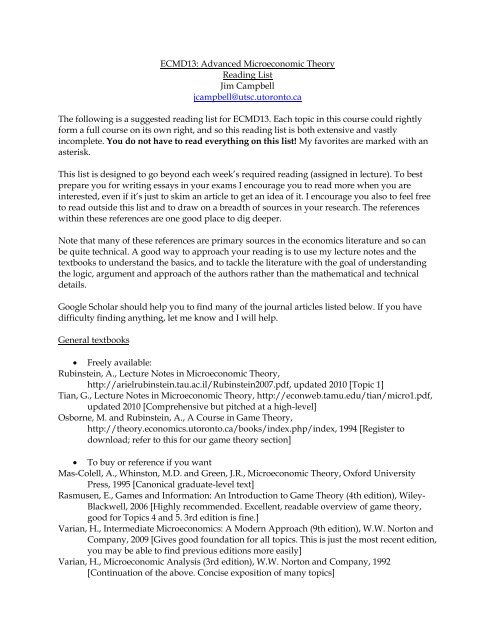
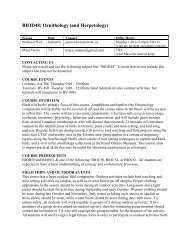
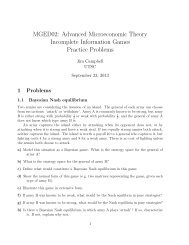


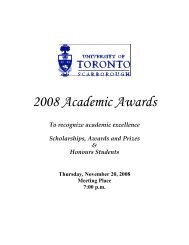
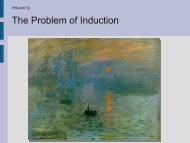
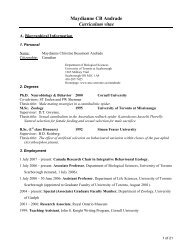
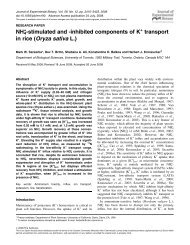
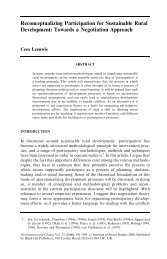
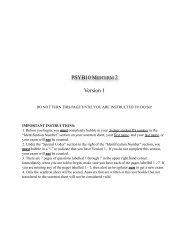
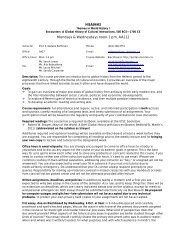
![[Enter course name - Syllabus] - University of Toronto Scarborough](https://img.yumpu.com/50068522/1/190x245/enter-course-name-syllabus-university-of-toronto-scarborough.jpg?quality=85)
